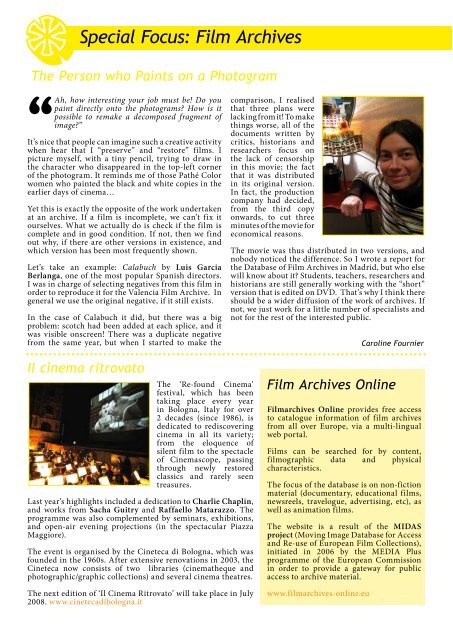Interview - Images for the future – Research blog
Interview - Images for the future – Research blog
Interview - Images for the future – Research blog
You also want an ePaper? Increase the reach of your titles
YUMPU automatically turns print PDFs into web optimized ePapers that Google loves.
*<br />
“Ah, how interesting your job must be! Do you<br />
paint directly onto <strong>the</strong> photograms? How is it<br />
possible to remake a decomposed fragment of<br />
image?”<br />
Special Focus: Film Archives<br />
The Person who Paints on a Photogram<br />
It’s nice that people can imagine such a creative activity<br />
when hear that I “preserve” and “restore” films. I<br />
picture myself, with a tiny pencil, trying to draw in<br />
<strong>the</strong> character who disappeared in <strong>the</strong> top-left corner<br />
of <strong>the</strong> photogram. It reminds me of those Pathé Color<br />
women who painted <strong>the</strong> black and white copies in <strong>the</strong><br />
earlier days of cinema…<br />
Yet this is exactly <strong>the</strong> opposite of <strong>the</strong> work undertaken<br />
at an archive. If a film is incomplete, we can’t fix it<br />
ourselves. What we actually do is check if <strong>the</strong> film is<br />
complete and in good condition. If not, <strong>the</strong>n we find<br />
out why, if <strong>the</strong>re are o<strong>the</strong>r versions in existence, and<br />
which version has been most frequently shown.<br />
Let’s take an example: Calabuch by Luis Garcia<br />
Berlanga, one of <strong>the</strong> most popular Spanish directors.<br />
I was in charge of selecting negatives from this film in<br />
order to reproduce it <strong>for</strong> <strong>the</strong> Valencia Film Archive. In<br />
general we use <strong>the</strong> original negative, if it still exists.<br />
In <strong>the</strong> case of Calabuch it did, but <strong>the</strong>re was a big<br />
problem: scotch had been added at each splice, and it<br />
was visible onscreen! There was a duplicate negative<br />
from <strong>the</strong> same year, but when I started to make <strong>the</strong><br />
II cinema ritrovato<br />
The ‘Re-found Cinema’<br />
festival, which has been<br />
taking place every year<br />
in Bologna, Italy <strong>for</strong> over<br />
2 decades (since 1986), is<br />
dedicated to rediscovering<br />
cinema in all its variety;<br />
from <strong>the</strong> eloquence of<br />
silent film to <strong>the</strong> spectacle<br />
of Cinemascope, passing<br />
through newly restored<br />
classics and rarely seen<br />
treasures.<br />
Last year’s highlights included a dedication to Charlie Chaplin,<br />
and works from Sacha Guitry and Raffaello Matarazzo. The<br />
programme was also complemented by seminars, exhibitions,<br />
and open-air evening projections (in <strong>the</strong> spectacular Piazza<br />
Maggiore).<br />
The event is organised by <strong>the</strong> Cineteca di Bologna, which was<br />
founded in <strong>the</strong> 1960s. After extensive renovations in 2003, <strong>the</strong><br />
Cineteca now consists of two libraries (cinema<strong>the</strong>que and<br />
photographic/graphic collections) and several cinema <strong>the</strong>atres.<br />
The next edition of ‘Il Cinema Ritrovato’ will take place in July<br />
2008. www.cinetecadibologna.it<br />
comparison, I realised<br />
that three plans were<br />
lacking from it! To make<br />
things worse, all of <strong>the</strong><br />
documents written by<br />
critics, historians and<br />
researchers focus on<br />
<strong>the</strong> lack of censorship<br />
in this movie; <strong>the</strong> fact<br />
that it was distributed<br />
in its original version.<br />
In fact, <strong>the</strong> production<br />
company had decided,<br />
from <strong>the</strong> third copy<br />
onwards, to cut three<br />
minutes of <strong>the</strong> movie <strong>for</strong><br />
economical reasons.<br />
The movie was thus distributed in two versions, and<br />
nobody noticed <strong>the</strong> difference. So I wrote a report <strong>for</strong><br />
<strong>the</strong> Database of Film Archives in Madrid, but who else<br />
will know about it? Students, teachers, researchers and<br />
historians are still generally working with <strong>the</strong> “short”<br />
version that is edited on DVD. That’s why I think <strong>the</strong>re<br />
should be a wider diffusion of <strong>the</strong> work of archives. If<br />
not, we just work <strong>for</strong> a little number of specialists and<br />
not <strong>for</strong> <strong>the</strong> rest of <strong>the</strong> interested public.<br />
Caroline Fournier<br />
Film Archives Online<br />
Filmarchives Online provides free access<br />
to catalogue in<strong>for</strong>mation of film archives<br />
from all over Europe, via a multi-lingual<br />
web portal.<br />
Films can be searched <strong>for</strong> by content,<br />
filmographic data and physical<br />
characteristics.<br />
The focus of <strong>the</strong> database is on non-fiction<br />
material (documentary, educational films,<br />
newsreels, travelogue, advertising, etc), as<br />
well as animation films.<br />
The website is a result of <strong>the</strong> MIDAS<br />
project (Moving Image Database <strong>for</strong> Access<br />
and Re-use of European Film Collections),<br />
initiated in 2006 by <strong>the</strong> MEDIA Plus<br />
programme of <strong>the</strong> European Commission<br />
in order to provide a gateway <strong>for</strong> public<br />
access to archive material.<br />
www.filmarchives-online.eu


